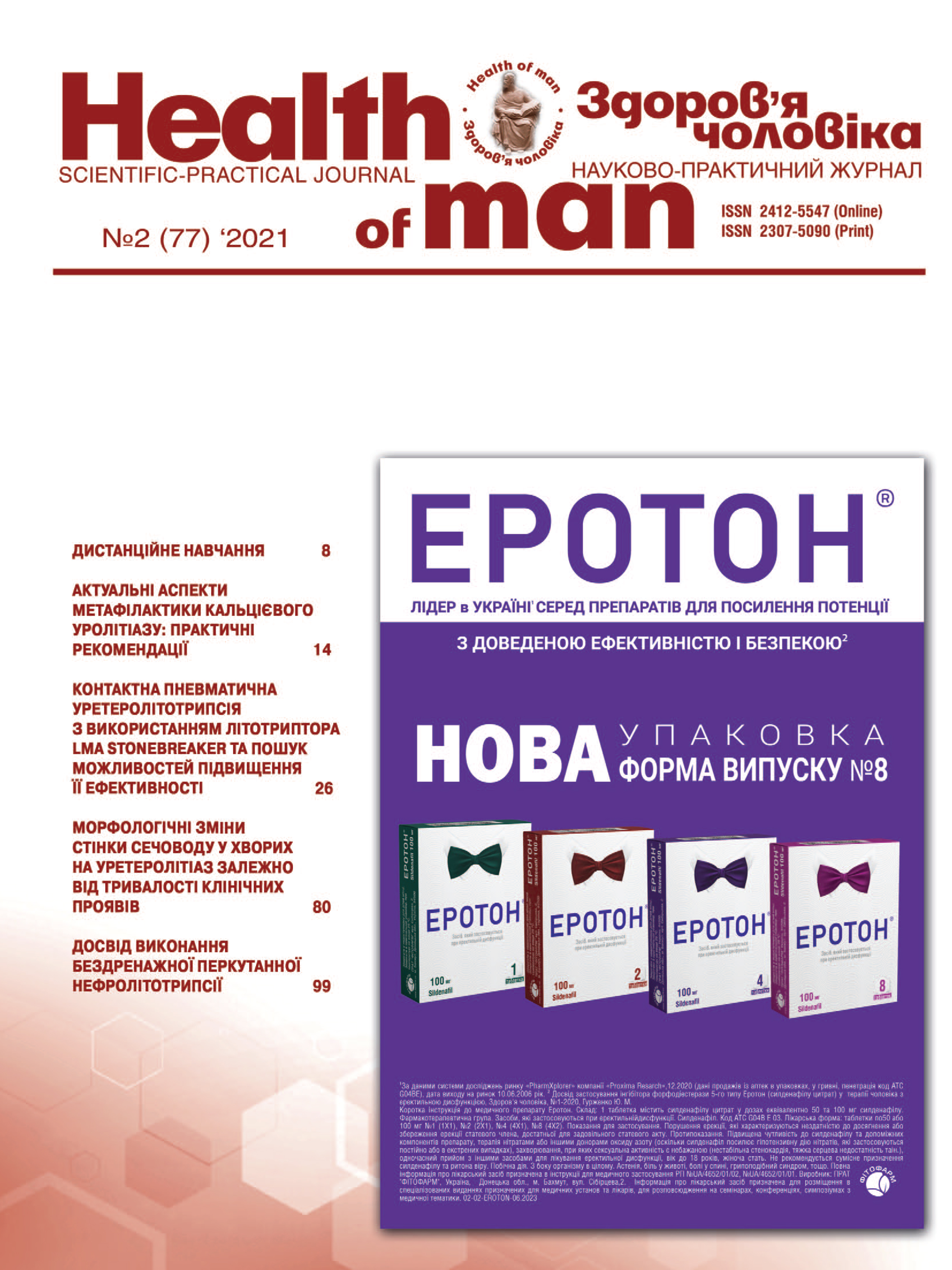Morphological Changes of the Ureter in Patients with Ureterolithiasis Depending on the Duration of Clinical Manifestations
##plugins.themes.bootstrap3.article.main##
Abstract
Urolithiasis (URL) is a common urological disease that often appears in the population, has a high recurrent rate and a significant impact on the social status of the population. Almost half of patients with URL disease are people with ureteric stones, 95% of which have secondary genesis. The main methods of treatment of such patients are extracorporeal shock-wave lithotripsy (ESWL) and ureterolithotripsy (URS). It is important in these cases to determine morphological changes (inflammation, edema, sclerosis, necrosis, etc.) that appear in the ureter in the placement of the stone and may reduce the effectiveness of minimally invasive treatment or/and removal of fragments during URS.
The objective: studying morphological changes of the ureter wall in patients with ureterolithiasis in the zone of the calculus in dependence of the duration of clinical manifestations.
Materials and methods. We have studied histological changes of the ureter wall in the location of the stone in patients with ureterolithiasis. We explored the ureter wall in patients depending on duration of typical manifestations of ureterolithiasis, which were 7-en days long, 30 days, and more than 2 months.
Results. If the stone in the ureter is up to 7 days, it does not cause significant microscopic changes of the ureter wall. If the stone been in the ureter during 1 month, more significant morphological changes are determined with desquamation of the urothelium, edema and inflammatory changes in the submucosal membrane. In case of the duration of the calculi in the ureter is more than 2 months, we noted the exfoliation of the urothelium with the denudation of the basement membrane. In the submucosal layer there is an edema, diffuse disorganization of connective tissue fibers, fragments of growth of granulation tissue and dense connective tissue in the form of separate layers.
Conclusion. With increasing duration of the disease in the wall of the ureter increases the manifestations of inflammatory, sclerotic and necrotic changes. Such changes have a direct impact on the quality of visualization of the calculus during endoscopic interventions, the rate of fragmentation and extraction (elimination) of fragments, as a consequence, increase the overall duration of the operation and the risk of intra- and postoperative complications.
##plugins.themes.bootstrap3.article.details##

This work is licensed under a Creative Commons Attribution 4.0 International License.
Authors retain the copyright and grant the journal the first publication of original scientific articles under the Creative Commons Attribution 4.0 International License, which allows others to distribute work with acknowledgment of authorship and first publication in this journal.
References
Türk C, Knoll T, Petrik A, et al. EAU guidelines on interventional treatment for urolithiasis. Eur. Urol. 2015;69(3):475–82. Available from: https://doi.org/10.1016/j.eururo.2015.07.041.
Assimos D, Krambeck A, Miller NL et al. Surgical management of stones: American Urological Association/Endourological Society Guideline. J. Urol. 2016;196(4):1153–1160. Available from: https://doi.org10.1016/j.juro.2016.05.090.
McClinton S, Cameron S, Starr K, et al. TISU: Extracorporeal shockwave lithotripsy, as first treatment option, compared with direct progression to ureteroscopic treatment, for ureteric stones: study protocol for a randomised controlled trial. Trials. 2018;19:286. Available from: https://doi.org/10.1186/s13063-018-2652-1.
Shinde S, Al Balushi Y, Hossny M, et al. Factors Affecting the Outcome of Extracorporeal Shockwave Lithotripsy in Urinary Stone Treatment. Oman. Med. J. 2018;33(3):209–17. Available from: https://doi.org/10.5001/omj.2018.39.
Sarica K, Kafkasli A, Yazici Ö, et al. Ureteral wall thickness at the impacted ureteral stone site: a critical predictor for success rates after SWL. Urolithiasis. 2014;43(1):83–8. Available from: https://doi.org/10.1007/s00240-014-0724-6.
Minei S, Yamazaki T, Kaya H, et al. Characterization of ureteral lesions associated with impacted stones. Int. J. Urol. 1999;6(6):281–5. Available from: https://doi.org/10.1046/j.1442-2042.1999.00067.x.
Hamamoto S, Okada S, Inoue T, et al. Prospective evaluation and classification of endoscopic findings for ureteral calculi. Sci. Rep. 2020;10:12292. Available from: https://doi.org/10.1038/s41598-020-69158-w.
Lesovoy VN, Yakovtova II, Danilyuk SV, et al. Morphofunctional state of the ureter wall in the experimental modeling of uretherolithiasis. Urologiya. 2017;21(80):22–7.





